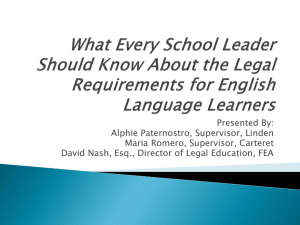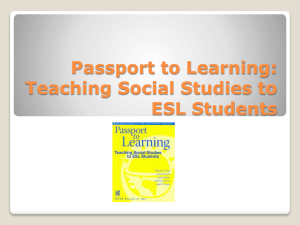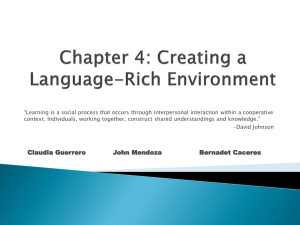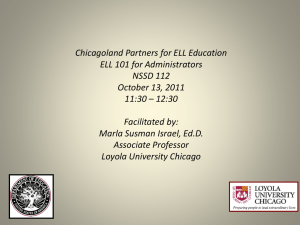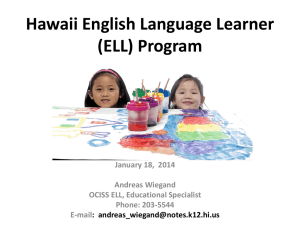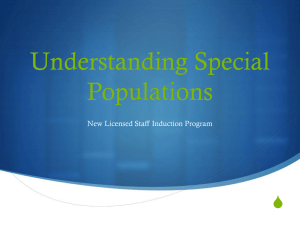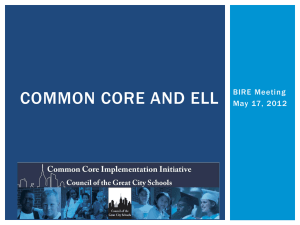When Is It Appropriate to Refer an ELL for Special Education?
advertisement
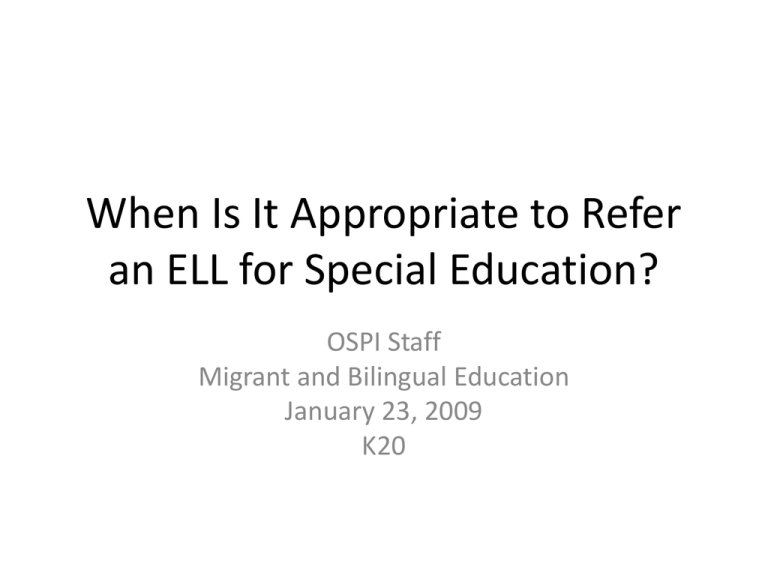
When Is It Appropriate to Refer an ELL for Special Education? OSPI Staff Migrant and Bilingual Education January 23, 2009 K20 10 Questions to Consider 1. How have I honored the referring teacher’s concern? 2. Do we have a clear pre-referral process in place? 3. Who is the gatekeeper within the ELL program who is contacted for every pre-referral? 4. To what extent does everyone understand language development? 5. Is the ELL exhibiting atypical performance? 6. To whom is the ELL being compared? 7. What data should I look at for the peer comparison? 8. What role does Response-To-Intervention (RTI) play in the prereferral process? 9. To what extent are parents involved? 10. To what extent are district ELL/Special Ed trends being scrutinized? 1. How have I honored the referring teacher’s concern? Do’s Don’t • Respect that the teacher wants the child to succeed. • Respect that the teacher is probably doing the best she can with what she knows. • Respect the teacher’s understanding of pedagogy. • Offer immediate assistance – observations, co-planning, modifications. • Dismiss the teacher’s concerns as unimportant or foolish (this leads to stealth referrals and a competition to qualify an ELL just out of spite). • Make the teacher feel ignorant because she doesn’t have a background in ELL issues. • Promise something that you can’t/won’t deliver on. A Quote from Research One of the most common reasons for referrals to special education has been limited English proficiency (MaldonadoColón, 1986). This is the case despite the fact that limited English proficiency, when it stems from the presence of a nonEnglish language in the child's home, has, in and of itself, no negative effects on learning. […] When, however, no accommodations are made to a child's lack of proficiency in the language of the EC [early childhood] setting, children are left without means of understanding what is being said or expressing what they need to say. Their performance then becomes similar to that of children with disabilities. SOURCE: Barrera, Isaura (1995). To Refer Or Not to Refer: Untangling the Web of Diversity,"Deficit," and Disability. In: New York State Association for Bilingual Education Journal v10 p54-66, Summer 1995 2. Do we have a clear pre-referral process in place? • Create a process with a multi-disciplinary team: Special Ed “best friend”, content and/or grade-level teacher, administrator, ELL staff. • Get approval for the process and communicate it often to all staff. • Avoid an overwhelmingly complex process if the majority of referrals are based on simple misinformation. Another Quote from Research If […] the child has intact learning abilities and an age appropriate repertoire of skills, but can not understand the language of instruction, it is equally inappropriate and wasteful of both financial and human resources to generate a complete interdisciplinary assessment and special education program instead of simply providing needed linguistic support. SOURCE: Barrera, Isaura (1995). To Refer Or Not to Refer: Untangling the Web of Diversity,"Deficit," and Disability. In: New York State Association for Bilingual Education Journal v10 p54-66, Summer 1995 Sample Process Overview Process for Addressing Concerns Identify Concern Modifications, Interventions, Consult with ESL Staff Contact parents regarding concern Complete Checklist and meet with Child Study Team If no progress is made, return to Child Study Team Other interventions, such as homework center, tutors, etc. 3. Who is the gatekeeper within ELL who is contacted for every pre-referral? No one has all the knowledge about ELL/Special Ed referrals, but … • When a Special Ed or ELL staff person suggests that “Yes, this kid probably is Special Ed” before knowing all the facts, it is difficult to bring any contradictory information to the table. • Many ELLs are referred because they were referred at an earlier grade. 4. To what extent does everyone understand language development? • • • • • Avoid these common fallacies: No English = No intelligence/learning Social, oral language (BICS) = academic language (CALPs) Judging GLEs without ELD standards Ignoring time as a crucial factor in language development Ignoring the role of dominant language Dominant Language An English language learner has: • a dominant language for home, family, church, shopping (usually the first language, remains at a simple level unless child receives direct instruction in this language). • another dominant language for school and academic situations (usually the language of instruction, proficiency will continue to increase). howard.deleeuw@k12.wa.us 10 5. Is the ELL exhibiting atypical performance? • Franklin Bender “Difference vs. Disability: The Continuum of Working with English Language Learners” from National CEU. www.NationalCEU.com • Catherine Collier “Separating Difference from Disability” www.crosscultured.com • Evaluation and Assessment in Early Childhood Special Education: Children Who Are Culturally and Linguistically Diverse www.k12.wa.us/SpecialEd/pubdocs/CLD.doc Quote from SpEd OSPI document A formal referral to special services is only justified after it has been determined that a child’s behavior and performance cannot be explained solely by language or cultural differences, the acculturation process, or the learning environment. - pg. 22, OSPI pamphlet 6. To whom is the ELL student being compared? • A peer analysis is critical in determining if the student’s performance is atypical. • The ideal peer group are ELLs, same language background, same time in program, same grade of entry in school. • Scour district longitudinal data and find as large a peer group as possible When children are learning English as a second language: When children have a language impairment or disorder: • it is typical for their skills in English vocabulary, pronunciation, grammar, and comprehension to be less well- developed than their peers who only speak English. • errors or limited skills in vocabulary, pronunciation, grammar, and comprehension interfere with communication in their first language (L1), compared to peers from the same language group. • they will acquire English in a predictable developmental sequence, similar to younger children who are beginning to learn English. • • reduced opportunities to use their first • language may result in loss of competence in L1 before becoming proficient in English. their English skills are delayed in comparison to peers from the same language group who have been learning English for the same length of time. their communication is impaired in interactions with family members and others who speak the same language. • they may switch back and forth between L1 • and English, using their most sophisticated skills in both languages within single utterances. results from assessments conducted in • English are unlikely to reflect the child’s true skills and abilities in most domains. • skills in their first language will be limited, inappropriate, or confused in content, form, or use. assessments conducted in English will be unable to discriminate between language acquisition and language disorder. (Source: OSPI Pamphlet, p. 12) Appropriate Comparison or Not? • ELL 3rd grader to all 3rd graders? • ELL to all ELLs in the district? • ELL Spanish speaker to all ELL Spanish speakers? • ELL to older or younger sibling? 7. What data should I look at for the peer comparison? • • • • • • • Years in program Entry grade WLPT-II levels WASL scores Mobility Parent input There is always more to find out… District Data Example Comparison of Test History to Peers (same language group, same entry grade, same time in US) WLPTII Spring 2006 • 55 ELL 7th graders completed the test • 1 Level 1, avg. years in program – 1 • 12 Level 2s, avg. years in program – 2.4 • 31 Level 3s, avg. years in program – 4.9 (Student X is in this group) • 11 Level 4s, avg. years in program – 5.6 Currently have 25 Russian ELLs in 8th grade. Average length of time in program has been just over 4.1 years. • Of the 57 8th graders in the district who used to be in ELD, the average length of time in program prior to exit was 4.3 years. Of these, 29 are Russian speakers, who were in the program an average of 4 years. • Of the 33 ELLs who have exited the program, and who started in 2nd grade, the average years in program prior to exit was 4.1 years. • Of the 17 Russian ELLs who took the 7th grade WASL last year, the reading scores were: 8 Level 1s (Student X is in this group), and 9 Level 2s. • The math scores were: 10 Level 1s (Student X was in this group), 6 Level 2s, and 1 Level 3. WLPT-II for Kindergarten Spring 2008 COMPOSITE LEVEL L1 L2 L3 L4 (blank) Grand Total Total COMPOSITE LEVEL L1 L2 L3 L4 Grand Total ENTRY DATE Total 9/5/2007 118 9/5/2007 1227 9/5/2007 648 9/5/2007 125 2118 Level L1 L2 L3 L4 Grand Total Entry Date Lang 9/5/2007Spanish 9/5/2007Spanish 9/5/2007Spanish 9/5/2007Spanish 1141 7531 3514 631 12817 SPA Level L1 L2 L3 L4 Total Lang Total Spanish Spanish Spanish Spanish 862 5104 2030 195 8191 Level District L1 NK L2 NK L3 NK Grand Total Total 88 647 258 24 1017 Level 2 Scale Score 509 to 534 Total 1 14 7 22 Total 2245 536 257 538 to 565 5029 8. What role does Response-To-Intervention (RTI) play in the pre-referral process? There is great promise […] in using an RTI approach for many reasons. First, the universal screening and progress monitoring called for in the RTI process allow for comparison of students to other similar or “true” peers in their local cohort rather than to national norms. Second, an effective RTI model requires collaboration among all educators (e.g. speech and language therapists, school psychologists, counselors, English as a second language/Bilingual specialist) thereby providing increased opportunities for professional dialogue, peer coaching, and the creation of instructional models integrating best practices of the various fields of education and related services. Source: “A Cultural, Linguistic, and Ecological Framework for Response to Intervention with English Language Learners” Julie Esparza Brown, Portland State University, 2008. Quote Students who have disorders that interfere with the teaching and learning process should be referred to special education programs that will allow them to develop the skills necessary for full participation in society. However, it is vital to distinguish students who are experiencing difficulties in school because of limited English skills from students who are handicapped. Inappropriate referral to special education can be stigmatizing and costly, and can inhibit limited-English-proficient students from achieving their full academic potential. SOURCE: Olson, Paula. (1991) Referring Language Minority Students to Special Education. ERIC Digest. ED329131 Mar 91 9. To what extent are parents involved? • Parents need to be contacted early in a language they understand regarding the teacher’s concerns. • Parents need to be educated about language development and differences between siblings, the role of 1st language literacy, etc. 10. To what extent are district ELL/Special Ed trends being scrutinized? Sometimes individual schools and staff are unable to notice trends in referrals across the district. Here are some Spokane examples. Spokane Public Schools SpEd Statistics Group Total SpEd % English or no other language 28580 15.3% Language other than English 1670 5.1% Eligible ELLs 6% 986 Spokane Public Schools SpEd/ELL Statistics Language SpEd % Bosnian Total SpEd % Eligible ELLs 57 14% 30 Hmong 78 (50 or more) 23% 3.8% 37 5.4% Marshallese 140 1.4% 126 1.6% Russian 636 4.1% 331 4.8% Spanish 244 12.3% 162 12.3% Ukrainian 52 2% 29 3.5% 5% 67 9% Vietnamese 131
